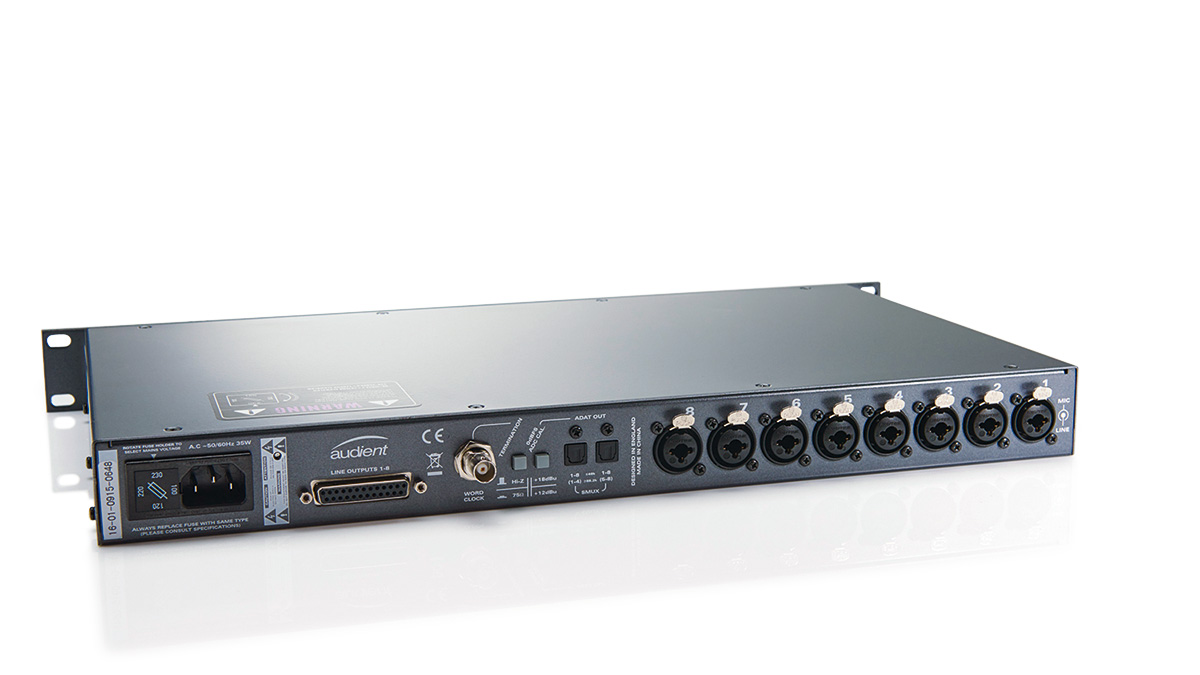MusicRadar Verdict
From build quality through to its high-quality conversion and sonic capabilities, an excellent unit.
Pros
- +
Good price. Punches above its weight.
Cons
- -
None.
MusicRadar's got your back

Audient ASP800 Multi-Channel Preamp

Audient ASP800 Multi-Channel Preamp
The first thing we think of when we hear the name Audient is great quality, clean recordings.
Having used both the consoles and mic pres on many occasions, we know we can rely on them to give us exactly what we expect from our choice of microphone and placement. Sometimes that is all you want but there are those times when you need a little extra, and that is where the new Iron and HMX circuits come in.
But, before we get on to the new bits, let's just recap on the fundamentals of the ASP800. As with all Audient products, the mic pres are the same as those in their flagship console the 8024. So sonically you have the same quality as the ASP880 which we loved.
Where it differs with the more expensive 880 (£739 inc VAT) is that here only channels 1 and 2 have polarity reverse, there are no insert points, no variable impedance and no variable HP filters.
The A/D converters are to all intents and purposes the same (but there is no output D/A) and really are exceptionally good for this price range. We compared them directly to our Prisms and they came out very well. Not quite the same depth and tonal range but at a fifth of the price they punch well above their weight.
Mic/Line connection is via Dual XLR /TRS jack sockets on the rear panel.Channels 1 and 2 also have front panel DI inputs, and then to the rear there are two ADAT outs (for 96kHz SMUX operation), a 25-pin D-Sub with eight analogue outs and a Word Clock input.
Sample rates are chosen using the switch on the front panel and, if you use external sync, the switch lights up solid when locked. The unit itself is surprisingly heavy and is very well built with a positive feel to all of the knobs and switches.
HMX and Iron
The new bit of the 800 is those first two channels with their HMX and Iron circuits. It's a real departure for Audient but their design team have a history that goes back to the '70s so these guys are designing these circuits from first-hand experience and knowledge.
Starting with the HMX circuit, this is a classic MOSFET design that gives asymmetrical harmonic distortion, thickening the sound and in subtler settings giving it depth and edge alongside a slightly limited sound that can really increase apparent volume. Good fun on a DI'd electric guitar and mic'd acoustic too.
With the electric it adds punch and warmth and on that acoustic it adds very controlled bite to the top. Used subtly on a vocal it adds clarity and I like that limited feel, especially on something aggressive.
Iron is based around a specially designed transformer and also has a MOSFET amplification section. This affects drive impedance, bass response, high-frequency damping, phase shift, magnetic saturation and transient shaping.
The curiosity for us here is that, while we would expect this to be perhaps more Neve like (which in its lower settings it is), as you push it there is a bit of vintage Trident there too. It's possible to get some edge as well as a warm blurring of the low-end and the upper mids get brought into focus. Great for drums and bass and really lovely on an acoustic guitar.
Sweet success
The secret with both of these sections is to experiment with the mic gain as well as the actual controls. With judicious use of input gain against effect setting you can hit a sweet spot for most sources.
Aside from the tonal variations there is always a touch of compression/limiting in there too which we find helps to get things to sit in a track without having to resort to bringing a compressor into play.
The ASP800 is a very useful tool. With its impressive basic pres and converters it's already better than many competitors in the same price range but, with the addition of those two variable channels, it is truly excellent and very capable of putting colour into your music. And for this price, it can only be considered a bargain.
"It was ugly, like watching a divorce between four people. After a while, I had to get out": Beatles engineer Geoff Emerick on the recording of Abbey Road, track-by-track
"I said, “What’s that?” and they said, “It’s what Quincy Jones and Bruce Swedien use on all the Michael Jackson records": Steve Levine reminisces on 50 years in the industry and where it’s heading next
“Excels at unique modulated timbres, atonal drones and microtonal sequences that reinvent themselves each time you dare to touch the synth”: Soma Laboratories Lyra-4 review









